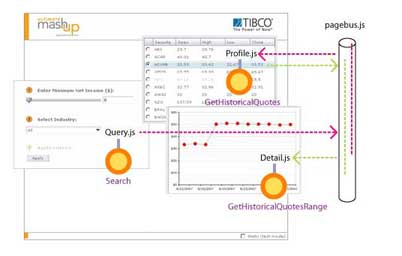Difference between revisions of "Inter Portlet Subscription/Notification Mechanism (Client side)"
| Line 17: | Line 17: | ||
| − | === | + | ===How to use TIBCO PageBus™ GWT Wrapper with D4Science Portlets== |
| − | + | ||
| − | + | '''Step 1st: Download the file needed [[Media:Pagesbus_Files.zip | Click here]]''' | |
| − | + | ||
| + | Once you extract the .zip file it contains three files, two .jar and one .js. | ||
Revision as of 18:31, 17 December 2008
How to make portlets in the same page use a Subscription/Notification Mechanism client side.
Pre-development Actions
Subscription/Notification Mechanism makes use of TIBCO PageBus™ (http://www.tibco.com/devnet/pagebus/default.jsp) which is an event and message bus implemented in JavaScript that enables disparate Ajax elements in a Web page to broadcast and listen for events and messages published on topic names.
For the ones developing portlets with GWT Wrapper exists for this Library, http://code.google.com/p/tibcopagebus4gwt/
However, the library does not currently support GWT 5.2, D4Science Portlets will have to use the same library modified to be compliant to GWT 5.2.
How does TIBCO PageBus™ help us?
PageBus helps developers drastically simplify development by using publish and subscribe APIs to send events and messages between components rather than get bogged down in point to point integrations between components that lead to unwieldy and less manageable code.
This diagram shows three Ajax widgets communicating with each other via the PageBus. Each widget has a file defining its visuals, a file controlling its behavior including the publish and subscribe calls to the PageBus, and a file that gets data from a service on the Web.
=How to use TIBCO PageBus™ GWT Wrapper with D4Science Portlets
Step 1st: Download the file needed Click here
Once you extract the .zip file it contains three files, two .jar and one .js.
